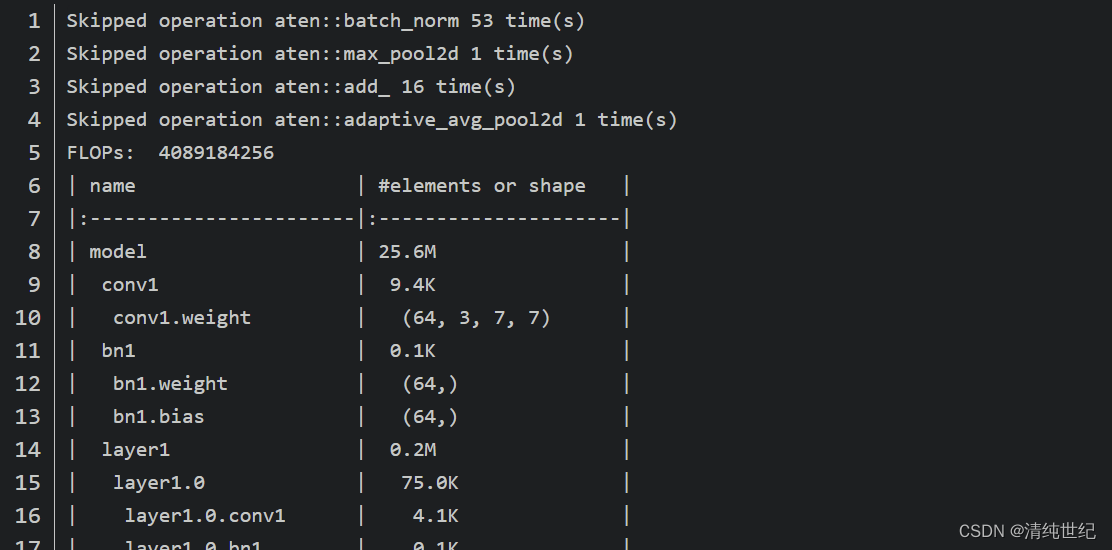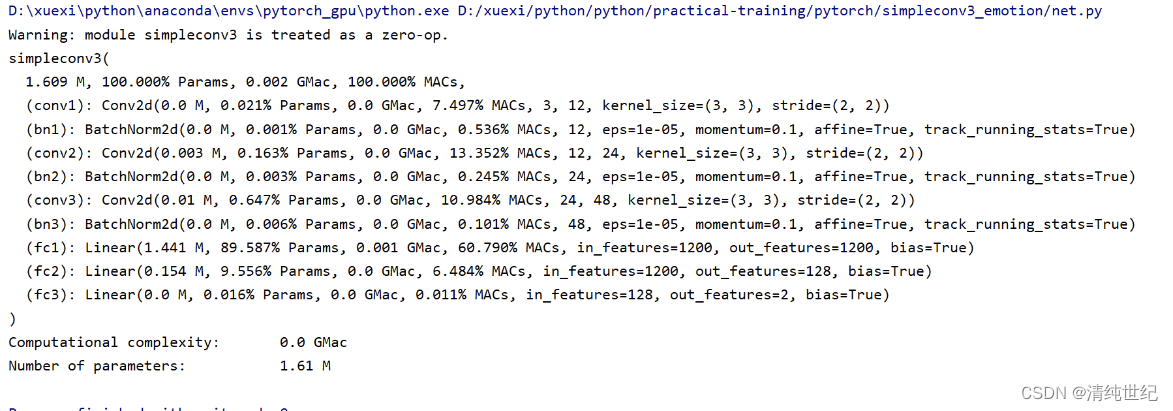目录
FLOPS和FLOPs的区别:
- FLOPS:注意全大写,是floating point operations per second的缩写,意指每秒浮点运算次数,理解为计算速度。是一个衡量硬件性能的指标。
- FLOPs:注意s小写,是floating point operations的缩写(s表复数),意指浮点运算数,理解为计算量。可以用来衡量算法/模型的复杂度。
在介绍torchstat包和thop包之前,先总结一下:
- torchstat包可以统计卷积神经网络和全连接神经网络的参数和计算量。
- thop包可以统计统计卷积神经网络、全连接神经网络以及循环神经网络的参数和计算量,程序示例等详见下文。
1、torchstat
pip install torchstat -i https://pypi.tuna.tsinghua.edu.cn/simple在实际操作中,我们可以调用torchstat包,帮助我们统计模型的parameters和FLOPs。如果不修改这个包里面的一些代码,那么这个包只适用于输入为3通道的图像的模型。
import torch
import torch.nn as nn
from torchstat import stat
class Simple(nn.Module):
def __init__(self):
super().__init__()
self.conv1 = nn.Conv2d(3, 16, 3, 1, padding=1, bias=False)
self.conv2 = nn.Conv2d(16, 32, 3, 1, padding=1, bias=False)
def forward(self, x):
x = self.conv1(x)
x = self.conv2(x)
return x
model = Simple()
stat(model, (3, 244, 244)) # 统计模型的参数量和FLOPs,(3,244,244)是输入图像的size
如果把torchstat包中的一行程序进行一点点改动,那么这个包可以用来统计全连接神经网络的参数量和计算量。当然手动计算全连接神经网络的参数量和计算量也很快 =_= 。进入torchstat源代码之后,如下图所示,注释掉圈红的地方,就可以用torchstat包统计全连接神经网络的参数量和计算量了。

2、thop
pip install thop -i https://pypi.tuna.tsinghua.edu.cn/simpleimport torch
import torch.nn as nn
from thop import profile
class Simple(nn.Module):
def __init__(self):
super().__init__()
self.fc1 = nn.Linear(10, 10)
def forward(self, x):
x = self.fc1(x)
return x
net = Simple()
input = torch.randn(1, 10) # batchsize=1, 输入向量长度为10
macs, params = profile(net, inputs=(input, ))
print(' FLOPs: ', macs*2) # 一般来讲,FLOPs是macs的两倍
print('params: ', params)3、fvcore
pip install fvcore -i https://pypi.tuna.tsinghua.edu.cn/simple用它比较好
import torch
from torchvision.models import resnet50
from fvcore.nn import FlopCountAnalysis, parameter_count_table
# 创建resnet50网络
model = resnet50(num_classes=1000)
# 创建输入网络的tensor
tensor = (torch.rand(1, 3, 224, 224),)
# 分析FLOPs
flops = FlopCountAnalysis(model, tensor)
print("FLOPs: ", flops.total())
# 分析parameters
print(parameter_count_table(model))终端输出结果如下,FLOPs为4089184256,模型参数数量约为25.6M(这里的参数数量和我自己计算的有些出入,主要是在BN模块中,这里只计算了beta和gamma两个训练参数,没有统计moving_mean和moving_var两个参数),具体可以看下我在官方提的issue。
通过终端打印的信息我们可以发现在计算FLOPs时并没有包含BN层,池化层还有普通的add操作(我发现计算FLOPs时并没有统一的规定,在github上看的计算FLOPs项目基本每个都不同,但计算出来的结果大同小异)。

注意:在使用fvcore模块计算模型的flops时,遇到了问题,记录一下解决方案。首先是在jit_analysis.py的589行出错。经过调试发现,op_counts.values()的类型是int32,但是计算要求的类型只能是int、float、np.float64和np.int64,因此需要手动进行强制转换。修改如下:

4、flops_counter
pip install ptflops -i https://pypi.tuna.tsinghua.edu.cn/simple用它也很好,结果和fvcore一样
from ptflops import get_model_complexity_info
macs, params = get_model_complexity_info(model, (112, 9, 9), as_strings=True,
print_per_layer_stat=True, verbose=True)
print('{:<30} {:<8}'.format('Computational complexity: ', macs))
print('{:<30} {:<8}'.format('Number of parameters: ', params))
5、自定义统计函数
import torch
import numpy as np
def calc_flops(model, input):
def conv_hook(self, input, output):
batch_size, input_channels, input_height, input_width = input[0].size()
output_channels, output_height, output_width = output[0].size()
kernel_ops = self.kernel_size[0] * self.kernel_size[1] * (self.in_channels / self.groups) * (
2 if multiply_adds else 1)
bias_ops = 1 if self.bias is not None else 0
params = output_channels * (kernel_ops + bias_ops)
flops = batch_size * params * output_height * output_width
list_conv.append(flops)
def linear_hook(self, input, output):
batch_size = input[0].size(0) if input[0].dim() == 2 else 1
num_steps = input[0].size(0)
weight_ops = self.weight.nelement() * (2 if multiply_adds else 1)
bias_ops = self.bias.nelement() if self.bias is not None else 0
flops = batch_size * (weight_ops + bias_ops)
flops *= num_steps
list_linear.append(flops)
def fsmn_hook(self, input, output):
batch_size = input[0].size(0) if input[0].dim() == 2 else 1
weight_ops = self.filter.nelement() * (2 if multiply_adds else 1)
num_steps = input[0].size(0)
flops = num_steps * weight_ops
flops *= batch_size
list_fsmn.append(flops)
def gru_cell(input_size, hidden_size, bias=True):
total_ops = 0
# r = \sigma(W_{ir} x + b_{ir} + W_{hr} h + b_{hr}) \\
# z = \sigma(W_{iz} x + b_{iz} + W_{hz} h + b_{hz}) \\
state_ops = (hidden_size + input_size) * hidden_size + hidden_size
if bias:
state_ops += hidden_size * 2
total_ops += state_ops * 2
# n = \tanh(W_{in} x + b_{in} + r * (W_{hn} h + b_{hn})) \\
total_ops += (hidden_size + input_size) * hidden_size + hidden_size
if bias:
total_ops += hidden_size * 2
# r hadamard : r * (~)
total_ops += hidden_size
# h' = (1 - z) * n + z * h
# hadamard hadamard add
total_ops += hidden_size * 3
return total_ops
def gru_hook(self, input, output):
batch_size = input[0].size(0) if input[0].dim() == 2 else 1
if self.batch_first:
batch_size = input[0].size(0)
num_steps = input[0].size(1)
else:
batch_size = input[0].size(1)
num_steps = input[0].size(0)
total_ops = 0
bias = self.bias
input_size = self.input_size
hidden_size = self.hidden_size
num_layers = self.num_layers
total_ops = 0
total_ops += gru_cell(input_size, hidden_size, bias)
for i in range(num_layers - 1):
total_ops += gru_cell(hidden_size, hidden_size, bias)
total_ops *= batch_size
total_ops *= num_steps
list_lstm.append(total_ops)
def lstm_cell(input_size, hidden_size, bias):
total_ops = 0
state_ops = (input_size + hidden_size) * hidden_size + hidden_size
if bias:
state_ops += hidden_size * 2
total_ops += state_ops * 4
total_ops += hidden_size * 3
total_ops += hidden_size
return total_ops
def lstm_hook(self, input, output):
batch_size = input[0].size(0) if input[0].dim() == 2 else 1
if self.batch_first:
batch_size = input[0].size(0)
num_steps = input[0].size(1)
else:
batch_size = input[0].size(1)
num_steps = input[0].size(0)
total_ops = 0
bias = self.bias
input_size = self.input_size
hidden_size = self.hidden_size
num_layers = self.num_layers
total_ops = 0
total_ops += lstm_cell(input_size, hidden_size, bias)
for i in range(num_layers - 1):
total_ops += lstm_cell(hidden_size, hidden_size, bias)
total_ops *= batch_size
total_ops *= num_steps
list_lstm.append(total_ops)
def bn_hook(self, input, output):
list_bn.append(input[0].nelement())
def relu_hook(self, input, output):
list_relu.append(input[0].nelement())
def pooling_hook(self, input, output):
batch_size, input_channels, input_height, input_width = input[0].size()
output_channels, output_height, output_width = output[0].size()
kernel_ops = self.kernel_size * self.kernel_size
bias_ops = 0
params = output_channels * (kernel_ops + bias_ops)
flops = batch_size * params * output_height * output_width
list_pooling.append(flops)
def foo(net):
childrens = list(net.children())
if not childrens:
print(net)
if isinstance(net, torch.nn.Conv2d) or isinstance(net, torch.nn.ConvTranspose2d):
net.register_forward_hook(conv_hook)
# print('conv_hook_ready')
if isinstance(net, torch.nn.Linear):
net.register_forward_hook(linear_hook)
# print('linear_hook_ready')
if isinstance(net, torch.nn.BatchNorm2d):
net.register_forward_hook(bn_hook)
# print('batch_norm_hook_ready')
if isinstance(net, torch.nn.ReLU) or isinstance(net, torch.nn.PReLU):
net.register_forward_hook(relu_hook)
# print('relu_hook_ready')
if isinstance(net, torch.nn.MaxPool2d) or isinstance(net, torch.nn.AvgPool2d):
net.register_forward_hook(pooling_hook)
# print('pooling_hook_ready')
if isinstance(net, torch.nn.LSTM):
net.register_forward_hook(lstm_hook)
# print('lstm_hook_ready')
if isinstance(net, torch.nn.GRU):
net.register_forward_hook(gru_hook)
# if isinstance(net, FSMNZQ):
# net.register_forward_hook(fsmn_hook)
# print('fsmn_hook_ready')
return
for c in childrens:
foo(c)
multiply_adds = False
list_conv, list_bn, list_relu, list_linear, list_pooling, list_lstm, list_fsmn = [], [], [], [], [], [], []
foo(model)
_ = model(input)
total_flops = (sum(list_conv) + sum(list_linear) + sum(list_bn) + sum(list_relu) + sum(list_pooling) + sum(
list_lstm) + sum(list_fsmn))
fsmn_flops = (sum(list_fsmn) + sum(list_linear))
lstm_flops = sum(list_lstm)
model_parameters = filter(lambda p: p.requires_grad, model.parameters())
params = sum([np.prod(p.size()) for p in model_parameters])
print('The network has {} params.'.format(params))
print(total_flops, fsmn_flops, lstm_flops)
print(' + Number of FLOPs: %.2f M' % (total_flops / 1000 ** 2))
return total_flops
if __name__ == '__main__':
from torchvision.models import resnet18
model = resnet18(num_classes=1000)
imput_size = torch.rand((1,3,224,224))
calc_flops(model, imput_size)
文章出处登录后可见!
已经登录?立即刷新
